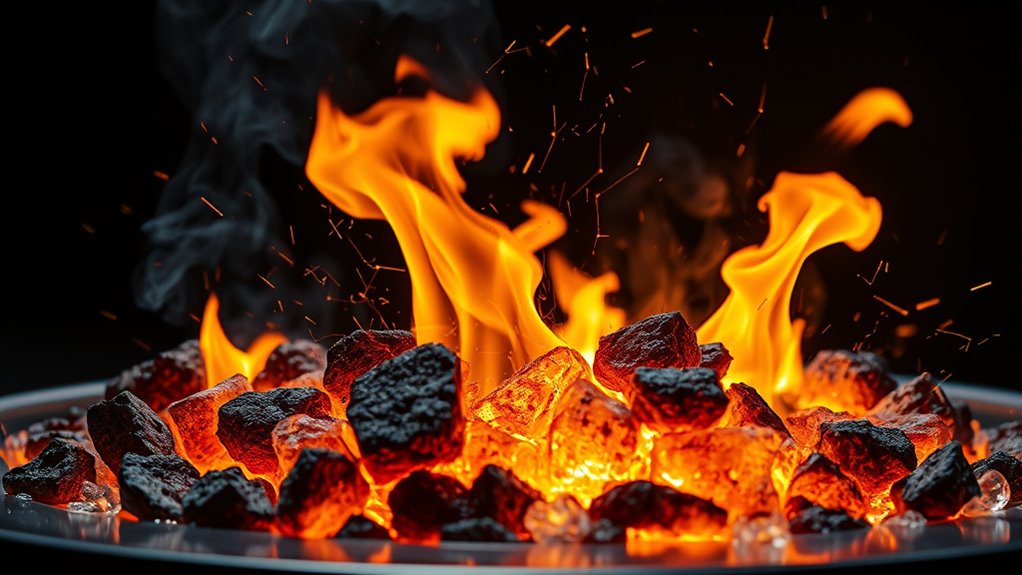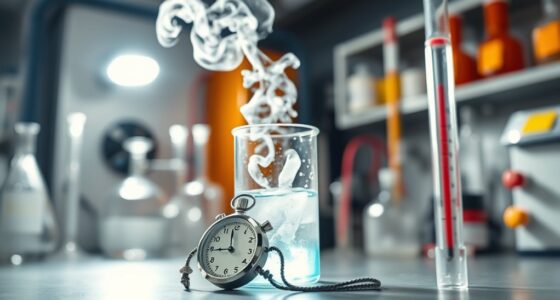Fire occurs through combustion, a chemical reaction where fuel mixes with oxygen and releases heat, light, and gases. This process involves radicals that propagate the reaction, which depends on temperature and oxygen availability. Oxidizers boost fire by providing oxygen or helping oxidize fuels. Flames show different colors based on the materials burned and combustion efficiency. To understand how these reactions truly work and stay safe, keep exploring the details behind the chemistry of fire.
Key Takeaways
- Combustion is a chemical reaction where fuel combines with oxygen, releasing heat, light, and sometimes sound.
- It involves radical chain reactions with reactive intermediates like radicals and radicals’ propagation.
- Oxidizing agents enhance combustion by providing oxygen or facilitating oxidation, increasing fire intensity and risk.
- Flame color indicates combustion efficiency and temperature; blue signifies complete combustion, red/yellow indicates incomplete burning.
- Proper safety measures and understanding combustion chemistry help prevent fires and mitigate environmental impacts.
Understanding the Basics of Combustion
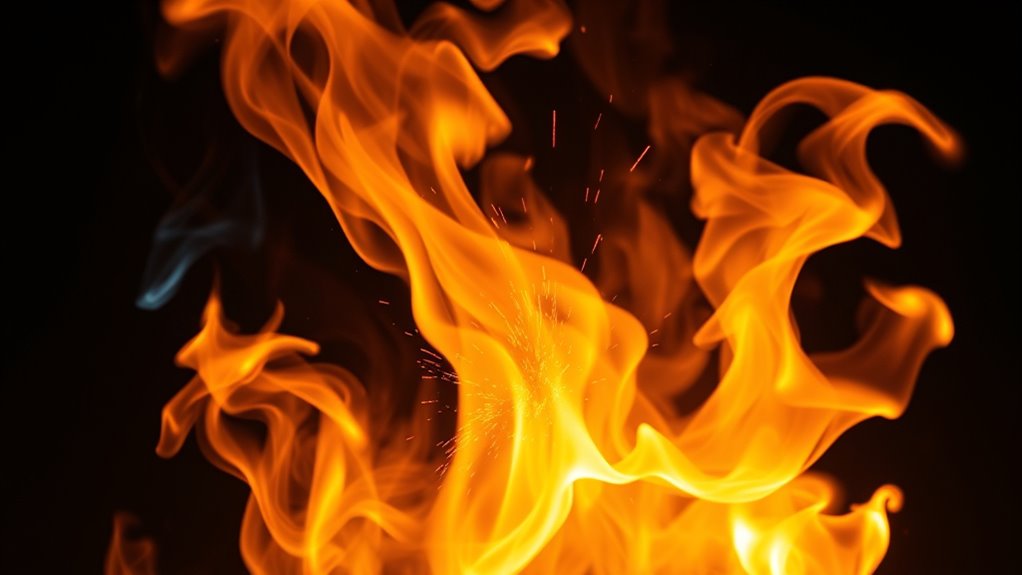
Understanding the basics of combustion is essential to grasp how fires start and sustain themselves. Combustion is a chemical reaction where a fuel combines with an oxidizer, usually oxygen, releasing energy as heat and light. Proper tracking of these elements is crucial for safety and efficiency in fire management. To ignite and keep burning, three ingredients are necessary: oxygen, heat, and fuel. Different fuels—solid, liquid, or gas—can undergo combustion, which can be complete or incomplete depending on the air-fuel ratio. This process is exothermic, meaning it produces heat, light, or even sound. The efficiency and characteristics of combustion depend on factors like fuel type, oxygen supply, and temperature. Recognizing these fundamental elements helps you understand how fires ignite, spread, and can be controlled or prevented.
The Chemical Mechanism Behind Burning
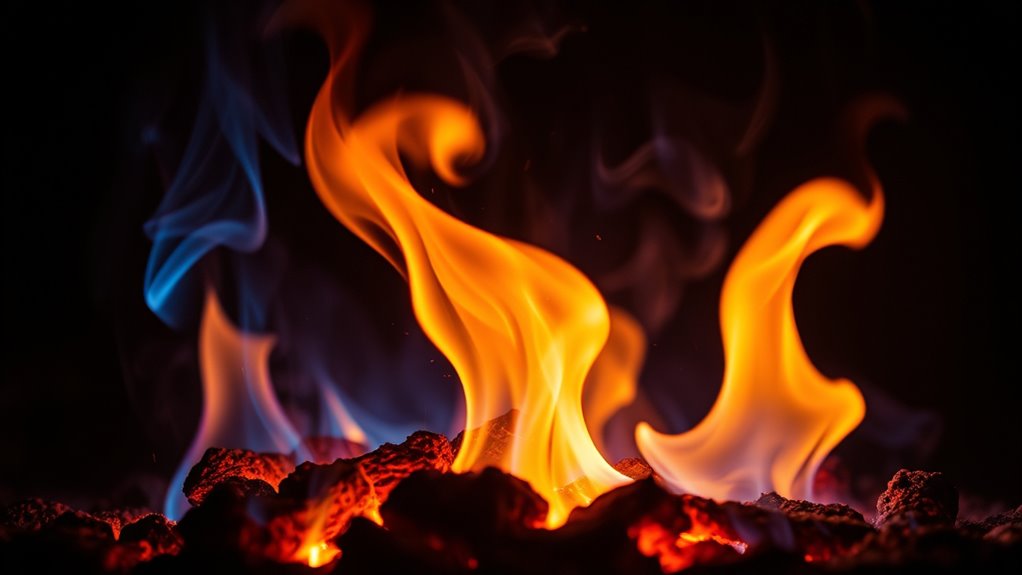
Have you ever wondered what happens at the molecular level when something burns? Combustion occurs through a radical chain reaction mechanism, involving reactive intermediates like singlet oxygen, hydroxyl, and hydroperoxyl radicals.
The process starts with high-energy initiation, where heat or a spark converts triplet oxygen into a reactive singlet state, overcoming quantum spin constraints. Hydrogen atoms are abstracted from hydrocarbons, forming hydroperoxide radicals that break down into hydroxyl radicals, fueling the chain reaction. The radicals are involved in elementary radical reactions, which are fundamental to the combustion process. These radicals are highly reactive but short-lived, continuously propagating the reaction. As the radicals react with fuel molecules, they produce intermediates like carbon monoxide and aldehydes. Temperature and oxygen availability also influence the reaction’s progression and the types of byproducts formed.
The reaction sustains itself as long as enough heat and radicals are present, until thermal equilibrium is achieved or conditions change.
The Role of Oxidizing Agents in Fire
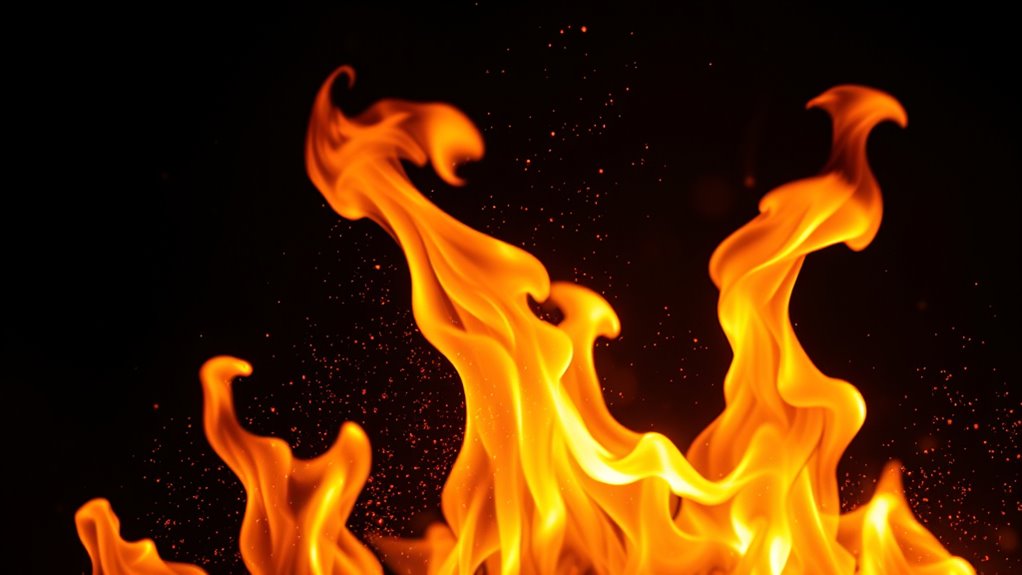
Ever wondered how certain substances make fires burn hotter and faster? That’s where oxidizing agents come in. These substances don’t burn themselves but promote combustion by providing oxygen or facilitating oxidation reactions. They can turn non-flammable materials into flames by increasing available oxygen, intensifying the fire. A deeper understanding of creative practice reveals that developing skills in handling these chemicals can be enhanced through consistent experimentation and learning. The strength of an oxidizer depends on its oxidation-reduction potential, with stronger agents like nitrates, chlorates, and bromates being more reactive. Oxidizers are classified based on their ability to accelerate burning and their potential to cause spontaneous ignition.
They can decompose at room temperature, releasing oxygen and raising fire risks. Handling these chemicals requires caution, as they may react violently with water or incompatible materials, considerably amplifying fire hazards.
Characteristics of Flames and Their Colors
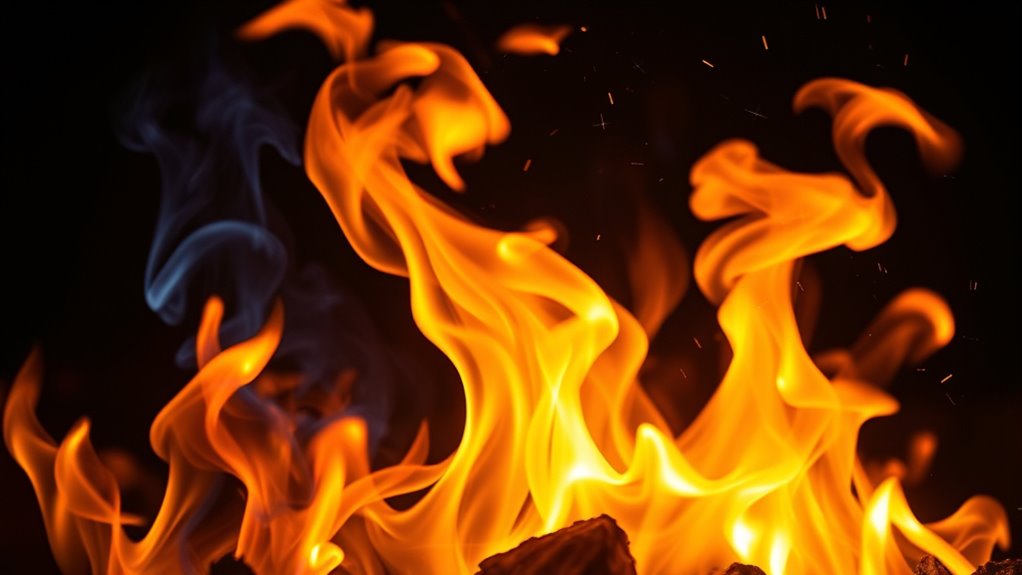
The colors of flames reveal a lot about the combustion process and the substances involved. When heat excites electrons in metals or organic compounds, they jump to higher energy levels. As electrons return to normal, they emit photons at specific wavelengths, creating visible colors. The ambiance of a dining establishment can sometimes be influenced by the materials used in its decor, much like how flame colors are determined by the elements present. For example, copper produces blue-green flames, strontium yields red, and potassium shows lilac. The flame’s color also indicates combustion efficiency: blue flames signify complete combustion, while yellow or red flames suggest incomplete burning and soot formation. Temperature influences color too—higher temperatures favor shorter wavelengths like blue or violet. Metal ions serve as diagnostic tools, allowing you to identify elements in materials. Organic fuels like wood or ethanol produce characteristic hues, depending on their carbon content and combustion conditions.
Safety Aspects and Practical Applications
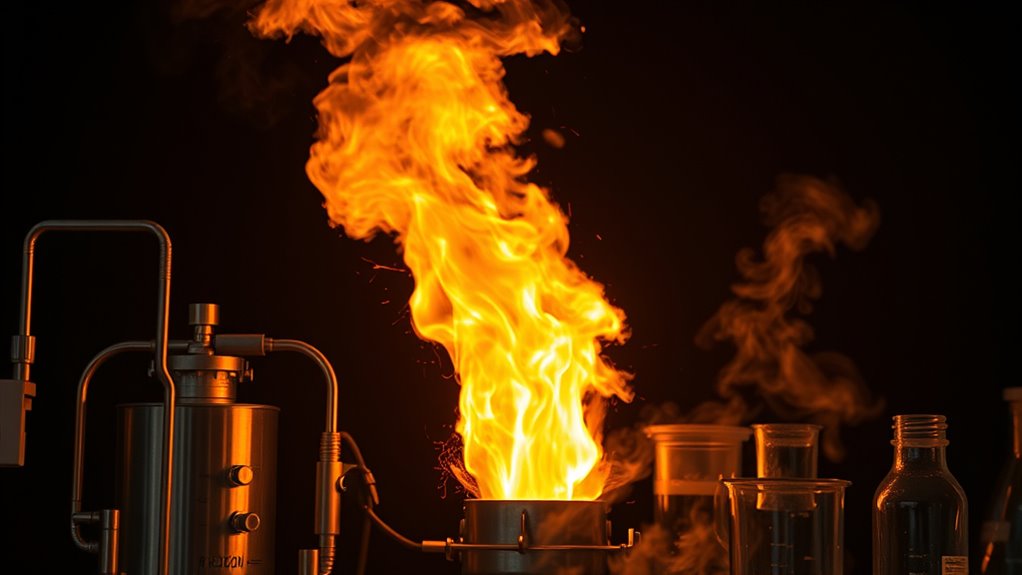
Understanding safety aspects and practical applications of fire management is essential to prevent accidents and protect lives and property. Regularly inspecting and maintaining electrical wiring and appliances minimizes ignition risks, while storing flammable materials properly prevents accidental fires. Avoid open flames and smoking in hazard zones to reduce outbreaks.
Prevent fires by inspecting electrical systems, storing flammable materials safely, and avoiding open flames in hazard zones.
A thorough knowledge of fire chemistry can help in understanding how different materials react during combustion, which is crucial for effective fire suppression. Strict housekeeping reduces combustible debris, and educating occupants about fire hazards boosts awareness and compliance. Installing smoke detectors and heat sensors provides early warnings, and ensuring fire alarm systems are functional on every floor ensures quick response.
Using automatic sprinklers and portable extinguishers helps control fires immediately. Fire-resistant barriers and proper compartmentation contain fires, limiting damage. Clear, well-lit exit routes and regular drills prepare occupants for evacuation.
These safety measures are vital for effective fire prevention and response.
Environmental Effects and Emission Concerns

How does burning hydrocarbons impact our environment? When you burn fossil fuels, you release carbon dioxide (CO2), a key greenhouse gas that traps heat and accelerates global warming. Elevated CO2 levels also cause ocean acidification, harming marine life.
Combustion produces air pollutants like carbon monoxide (CO), nitrogen oxides (NOx), and particulate matter (PM), which can cause respiratory problems, lung diseases, and even cancer.
Sulfur dioxide (SO2) reacts with moisture to create sulfuric acid, leading to acid rain that damages ecosystems, soil, and buildings.
Additionally, black carbon and toxic hydrocarbons like benzene pollute the air, harming both health and the environment. These emissions reduce air quality, contribute to smog, and threaten biodiversity, especially in urban areas where transportation is a major pollution source.
Understanding the environmental effects of emissions is crucial for developing cleaner energy solutions and reducing pollution impacts.
Frequently Asked Questions
How Does Pressure Influence the Combustion Process?
You see, pressure substantially impacts combustion by increasing reaction rates and heat efficiency. When pressure rises, reactant molecules collide more often and energetically, speeding up ignition and combustion.
Higher pressure also reduces ignition delay and creates denser fuel-air mixtures, improving fuel use. However, too much pressure can cause instabilities, so ideal levels are essential for stable and efficient combustion.
What Role Do Catalysts Play in Fire Reactions?
You might wonder what role catalysts play in fire reactions. Catalysts lower the activation energy needed for combustion, making reactions happen more easily at lower temperatures.
They provide an alternative pathway by helping break and form bonds on their surfaces, speeding up the process without being consumed. This helps control fire temperature, reduce emissions like NOx, and improve efficiency, making combustion cleaner and more environmentally friendly.
Can Combustion Occur Without Oxygen?
Imagine sparks flying in a darkened room, not from oxygen but from alternative sources. You can see that combustion doesn’t always need oxygen; elements like fluorine or chlorine can ignite reactions just as fiercely.
Hypergolic fuels ignite upon contact, and nuclear reactions produce blazing energy without traditional fire. So, yes, combustion can occur without oxygen, opening doors to new energy sources and dangerous, exciting chemical reactions.
How Do Different Fuels Affect Flame Temperature?
Different fuels markedly impact flame temperature. You’ll find that hydrogen reaches the highest temperatures, especially in oxygen, exceeding 3000°C.
Methane, ethane, and propane also produce high flames, with temperatures around 2000–2800°C in oxygen.
Heavier fuels like diesel produce lower temperatures.
The key is that cleaner, more complete combustion with fuels like hydrogen and methane in pure oxygen results in hotter flames, optimizing efficiency and specific applications.
What Are the Latest Innovations for Reducing Combustion Pollutants?
Think of combustion pollution reduction as upgrading your engine to run cleaner. You’re seeing innovations like improved fuel injection in aviation engines, which cuts soot, and zeolite-based catalysts that drastically lower NOx emissions at lower temperatures.
Advanced emission monitoring tools act like a fine-tuned radar, tracking pollutants precisely. These breakthroughs help power plants and vehicles breathe easier, making cleaner air a reality while keeping your environment safe and sustainable.
Conclusion
Think of fire as a dance between molecules, each step releasing energy and light. As you understand its chemistry, you become a mindful observer rather than a helpless spectator. Just like a skilled conductor guides an orchestra, knowing combustion’s secrets helps you harness fire safely and responsibly. Remember, you hold the baton—respect its power, protect what matters, and keep the dance of flames beautiful and controlled.
